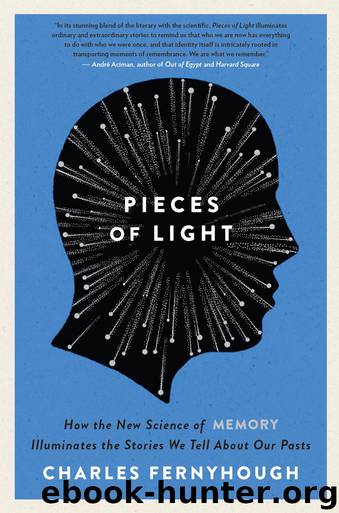Pieces of Light : How the New Science of Memory Illuminates the Stories We Tell About Our Pasts by Fernyhough Charles

Author:Fernyhough, Charles [Fernyhough, Charles]
Language: eng
Format: mobi
Publisher: HarperCollins
Published: 2013-02-26T05:00:00+00:00
WHEN MEMORY IS DISORDERED, CONFABULATIONS often follow. Moulin’s patient AKP would explain how he had already read the morning paper (which had actually only just arrived) by going out in the middle of the night to read it in the shop. When his wife once found a coin in the street, he explained his feeling of déjà vécu by claiming that he had placed it there himself. Even his wife became a topic of his mnemonic storytelling. He stated that he had married her, the same woman, three times, in separate ceremonies in different parts of Europe. On a visit to the cinema to watch a film that he was (naturally) convinced that he had already seen, he explained the anomalous feeling by claiming that the film was actually about him.
In many ways, confabulation is a perfectly understandable response to these odd feelings of remembering. Simply imagining a possible explanation for a weird experience might, through a source monitoring error, lead to it taking the form of a genuine memory. If there is concomitant damage to the control systems (predominantly housed in the prefrontal cortex) that usually police the outputs of the medial temporal lobe system, the “memory” might become firmly entrenched. If the relevant monitoring and control processes in the prefrontal cortex do not reject that imagining as spurious, it can come to be experienced as having the truth of a memory, and trigger a cascade of story making.
A second theory of confabulations proposes a failure of strategic retrieval, particularly in the systems (also housed in the prefrontal cortex, but in this case more laterally) that organize searches of memory and monitor the outputs of those memory searches. Again, strategic retrieval deficits cannot be the whole story. Frontal pathology is not always evident in confabulation cases (AKP had no damage in that region, for example), suggesting that other neural systems must be involved. The most comprehensive theories of confabulation now propose “core deficits” in certain key functions: the intuitive feeling of rightness of the memory; the monitoring of the outputs of the memory “editor”; and related control mechanisms that decide whether the memory should be acted upon.
This multiprocess view of confabulations would explain why déjà vécu confabulations have their distinctive recollective quality. AKP did not only believe that he had married the same woman three times; he actually remembered having done so. Having come up with an explanation for his anomalous experience, the monitoring systems that would usually reject it as implausible failed to weed it out. His overactive feeling of remembering led him to experience his explanatory story as a genuine memory. In other cases of confabulation, the patient actually goes on to act on the basis of the wonky beliefs. Patrick, as we have seen, went so far as to avoid his favorite pastime, watching golf on the television. There was no point in switching it on, he would reason, because he already knew the outcome of all the games.
Martin Conway has noted that confabulations often have a particular emotional valence, frequently working to show the ego in a good light.
Download
This site does not store any files on its server. We only index and link to content provided by other sites. Please contact the content providers to delete copyright contents if any and email us, we'll remove relevant links or contents immediately.
| Anatomy | Animals |
| Bacteriology | Biochemistry |
| Bioelectricity | Bioinformatics |
| Biology | Biophysics |
| Biotechnology | Botany |
| Ecology | Genetics |
| Paleontology | Plants |
| Taxonomic Classification | Zoology |
Sapiens: A Brief History of Humankind by Yuval Noah Harari(13123)
The Tidewater Tales by John Barth(12047)
Do No Harm Stories of Life, Death and Brain Surgery by Henry Marsh(6350)
Mastermind: How to Think Like Sherlock Holmes by Maria Konnikova(6275)
The Thirst by Nesbo Jo(5821)
Why We Sleep: Unlocking the Power of Sleep and Dreams by Matthew Walker(5680)
Sapiens by Yuval Noah Harari(4579)
Life 3.0: Being Human in the Age of Artificial Intelligence by Tegmark Max(4541)
The Longevity Diet by Valter Longo(4467)
The Rules Do Not Apply by Ariel Levy(3938)
The Body: A Guide for Occupants by Bill Bryson(3859)
The Immortal Life of Henrietta Lacks by Rebecca Skloot(3843)
Why We Sleep by Matthew Walker(3798)
Animal Frequency by Melissa Alvarez(3771)
Yoga Anatomy by Kaminoff Leslie(3726)
Barron's AP Biology by Goldberg M.S. Deborah T(3646)
The Hacking of the American Mind by Robert H. Lustig(3602)
All Creatures Great and Small by James Herriot(3542)
Yoga Anatomy by Leslie Kaminoff & Amy Matthews(3420)
